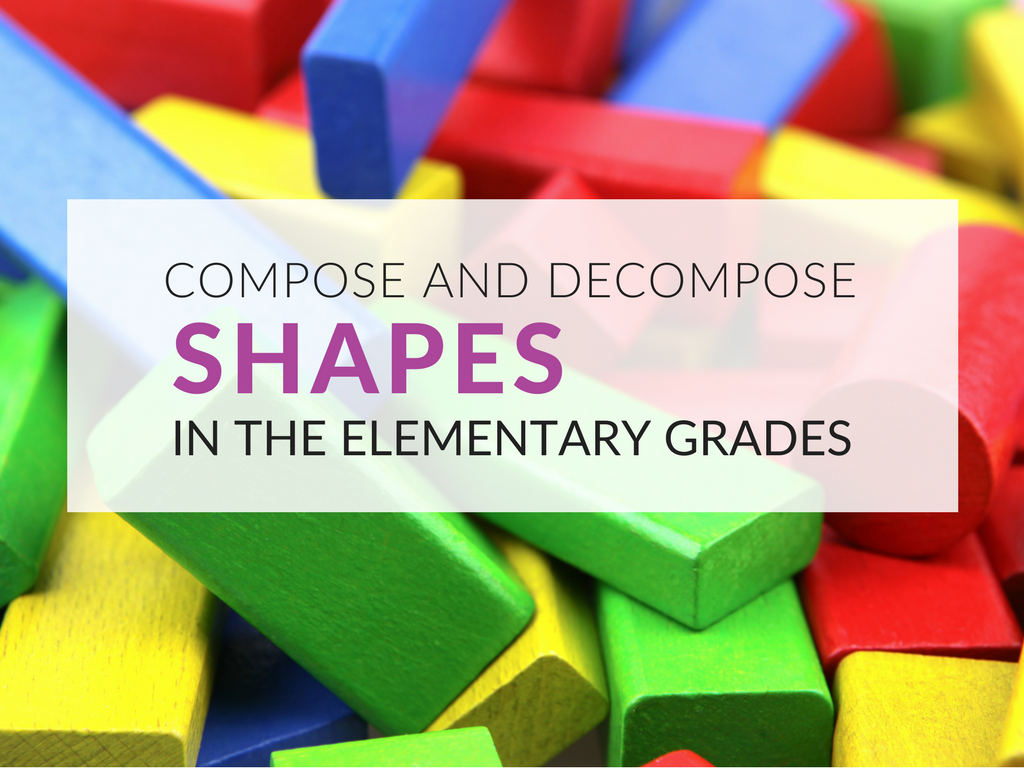May 15, 2018 k-2-geometry
Composing and Decomposing Shapes in K–2 [Includes Decomposing Worksheets]
By: Jeff Todd
Playing with pattern blocks, tangrams, and other manipulatives in order to create new shapes can be fun for early elementary students. In addition to being fun, there are many important concepts that students can develop while working to build and decompose shapes. This article discusses the concepts that can be developed, the kind of vocabulary students use to develop these concepts, and some tools you can use to help students build these ideas. The download that accompanies this post is a decomposing shapes worksheet with an answer key that you can use with your students today.

CONCEPTS THAT CAN BE ADDRESSED WITH COMPOSING AND DECOMPOSING SHAPES
Elementary students develop important concepts when they combine or divide geometric shapes. As they work with any of several manipulatives or create drawings, they are setting the stage for learning about area, fractions, and proportions.
Some important concepts that can be addressed as students work with composing and decomposing shapes at the early elementary level are:
-
Whether they are subdividing or building figures with equal sized pieces or not
-
The relative size of pieces (this is especially possible with pattern blocks and tangrams)
-
The names of figures and their number of sides and corners
-
Viewing a combination of figures as a single new figure
-
The simple tessellation of a plane by iterating figures (squares, rectangles, or even triangles) including the idea of rows and columns
KEY VOCABULARY FOR COMPOSING AND DECOMPOSING SHAPES
Student learn vocabulary as they describe the figures they use, how they are placed, and how they are moved. Students create simple tessellations by placing figures in rows and columns.
In describing what they are doing, student tap into the Standards for Mathematical Practice looking for and making use of structure, as well as attending to their precision of language in describing how they compose and decompose shapes. (Please see the companion article to this article for more about using these Standards for Mathematical Practice on this topic.)
Key vocabulary on this topic includes:
-
Above, below, next to, to the left of, to the right of, beside, in front of, behind
-
Rows, columns
-
Sides, corners
-
Flip, slide, turn (this looks forward to middle school topics, and need not be covered formally)
TOOLS TO HELP STUDENTS WITH COMPOSING AND DECOMPOSING SHAPES
There are several different types of manipulatives, materials, and technology that teachers can use to help students compose and decompose shapes.
Accounting for student differences, in general it is my belief that students should first build or create figures using manipulatives, and then recreate their drawings on paper. The process of internalizing the structure of figures and their re-creation gives evidence to teachers about the students’ understanding.
Here are several tools I have used to help students with composing and decomposing shapes:
-
Tangrams
-
Pattern blocks
-
Geoboards
-
Plain paper and dot paper
-
Square dot paper
-
Isometric dot paper
-
-
Geometry software and apps (if you need a free source, search the National Virtual Manipulative Library)
It is my experience that students love working with manipulatives in order to compose shapes. Remember, as you are designing your lessons, that students should have the opportunity to use vocabulary, and to re-create drawings of their manipulatives.
FREE DECOMPOSING SHAPES WORKSHEET
Finally, download the Ways to Make Plane Figures worksheets and use them as a classroom activity, homework assignment, or formative assessment. This two-page document and its answer key will help you assess your students’ progress.




